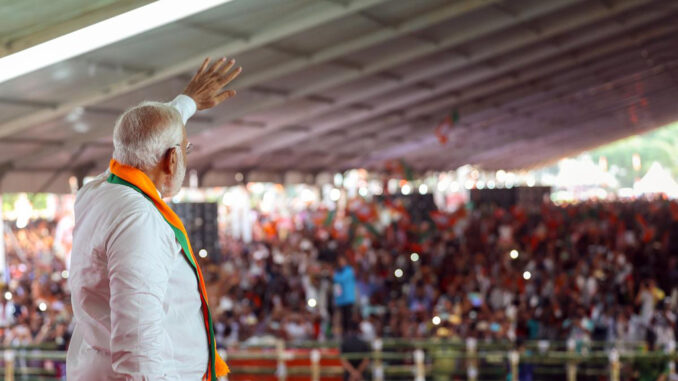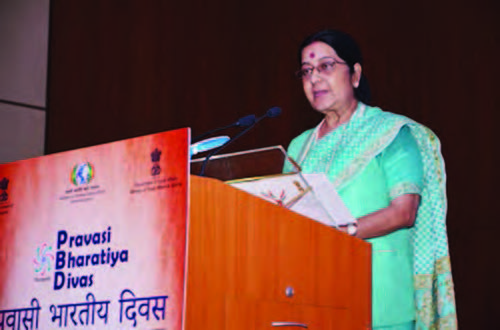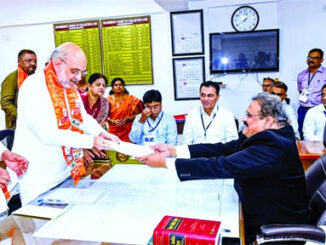
As Prime Minister Narendra Modi looked set to win a second term in 2019, Gabriele Parussini delved into the psychology of the country’s middle class voters who were the main engine behind his previous victory. His analysis is worth revisiting today.

Narendra Modi’s appeal to the middle class is a case study in political communication, as his style of populism does not neatly fit any typical framework long studied by academics.
In liberal democracies the world over, the middle class is known to be an anchor of stability and a defender of the status quo. Like elsewhere, members of India’s middle class are no revolutionaries. They support communal peace and social stability, they seek improvement through incremental change, not uprisings, and, above all, are keen to eschew politics altogether.
In a study of Indian middle-class voters during the 2019 election campaign, I found that most of them supported the status quo — a secular, multicultural India that emerged after Independence. These voters acknowledged the centripetal potential of religion in the Indian polity and assessed it negatively. This was true even among many supporters of Mr. Modi’s Bharatiya Janata Party (BJP).
Why then does this stability-loving middle class vote for a party whose policies are aimed at changing the secular status quo? Does its shift towards a national-populist party such as the BJP represent a rebellion, a rejection of the present order, or is it the result of other dynamics, including the perception that the party is not extremist anymore?
The answer, my research found, lies partly in a double messaging by Mr. Modi and the BJP.
Of the voters I interviewed, only a tiny minority — less than a tenth of the sample — supported unconditionally the BJP’s agenda items in their original, extreme, uncompromising form. A large majority of the participants, including BJP supporters, for instance, did not support the construction of the Ram temple in Ayodhya, because they were afraid it would spark violence. They supported a compromise, and did not fully believe that the party would go ahead with the creation of the temple. In short, the BJP’s promise of building the temple had low credibility.
Low credibility is usually a downside for a party because it undermines voter trust in its commitment. However, low credibility helped the BJP develop a double level of communication with its audience. The assumption that the party would not act on its most extreme, Hindutva– connotated proposals made it sound more innocuous to moderate middle-class voters.
This does not necessarily mean that there was discrepancy between the BJP’s message and the middle class’s understanding of it. Rather, the audience decoded the message in accordance with its own social and cultural context, even though it did not necessarily accept the underlying ideology. In other words, India’s middle class did not engage with the BJP’s entire message, ignoring the parts it found unacceptable.
The encoder of the political message — in this case Mr. Modi and the BJP — took advantage of the middle class’s willingness to ignore the obvious consequences of its choices by offering a pretense of moderation, which I call ‘implicit moderation’. Ultimately, however, this ‘implicit moderation’ only held true during the election campaign, fostering an impression that let voters believe that they were not choosing something revolutionary. Once it came to power, the BJP swayed to its more extreme instincts, taking peace-threatening measures such as construction of the Ram temple.
Another question this study set out to answer is to what extent the middle class is aware of the BJP’s attempts to create alternative narratives aimed at changing the public perception of the record.
I found that participants could separate the effective change that has been delivered and the impression of change that the BJP was eager to convey.
For instance, many of the participants noted that the BJP had tinkered with the names of welfare schemes since it got into power, such as by adding ‘PM’ to the names. One participant said that attention to public perception and promotion of government action were the main differences between the BJP government and its predecessor. “Maybe [the same] was happening with Congress. But [now] the media is promoting so much, [that] we know this is happening,” he said.
Despite understanding that the BJP constructs alternative narratives when it suits, middle-class voters support it again partly because of Mr. Modi’s communication.
When asked what the main measures adopted by the BJP-led government until 2019 are, two-thirds of the respondents mentioned either demonetization or the introduction of the goods and services tax, or GST.
The overwhelming majority of participants thought both of these measures caused large disruption, or their implementation was botched up. Still, many of them held a positive image of the party’s record in power, thanks to the government’s messaging.
In demonetization, for instance, the BJP built an alternative narrative, one in which Mr. Modi’s populist tactics are on full display.
The process set up was highly dramatic. Mr. Modi described himself as the hero who was leading a fight against an evil conspiracy. Demonetization became a moral tale where regular people are associated to the hero in a fight against the money hoarder, and, essentially, the rich. The revenge narrative had a wide appeal, irrespective of participants’ political allegiance. “The big people, the businessmen had the most problems…which was a good thing. Poor people did not have any problem,” said one participant.
Rather than focusing on the negative consequences of these measures, participants were swayed by Mr. Modi’s decisiveness. One BJP opponent said that “demonetization was very drastic”, but called it “a very good step” because Mr. Modi “didn’t think twice” about it. Mr. Modi’s decisiveness showed that he takes responsibility for his own actions, radical as they may be.
This research found that the middle class wants to see an affirmative, purposeful government that does not refrain from action, even if the rights and the freedom of some sections of society are curtailed.
In the last 10 years of his leadership, it is debatable whether Mr. Modi has been the ‘Vikas Purush’ or development man that he promised to be in 2014. But there is no debate that his development credentials with the middle class have been barely dented. That is thanks to his effective advertisement and the adoption of populist tactics to communicate with the audience. Populism thrives around a communication process that creates a direct connection between the leader and his audience, and Mr. Modi has created an original style of populism that academics are still studying.
The middle class can see through the BJP’s promotional effort, but tolerates the party’s aggressive communication style because it considers it to be fair game in politics. How this electorate votes in the ongoing elections will warrant further study not only to better understand the communication tools that work for populist leaders but also to get clues on the future of the world’s largest democracy.
(Gabriele Parussini, who was the India correspondent for The Wall Street Journal, decided in the late 2010s to pursue a PhD under the supervision of Christophe Jaffrelot and Rafal Zaborowski at King’s College, but died of blood cancer soon after submitting his thesis. He has just been awarded the title of doctor, posthumously.)





Be the first to comment